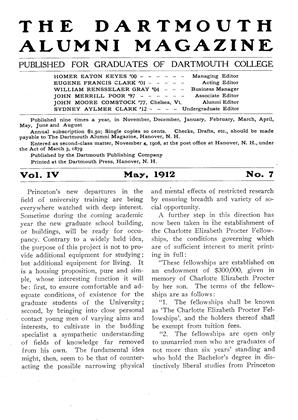The Registrar of the College, Mr. H., M. Tibbetts '00, has recently made a tour of investigation to study the dormitory systems of some of the eastern colleges. Among the institutions visited were Tufts, Harvard, Brown, Williams, Yale, Columbia, and Princeton. The object of the investigation was to compare the system in operation at Dartmouth with that in vogue elsewhere, with a view to making specific recomdations regarding new buildings, and to serve as a basis for regrading the rental values of rooms. In regard to the prices of rooms it was found that for the best rooms in other colleges, in general not offering the occupant any greater advantages, the prices were considerably higher than for the best rooms at Dartmouth. The medium and lowpriced rooms vary but little at different institutions.
As regards the plan of building it was found that the entry system of dormitories was generally used in the newer buildings, allowing from four to eight occupants on each floor of each entry. The chief advantage of this lies in its freedom from noise and general disturbance. Other features in general use are enamel brick hallways, pressed steel doors, elimination of all wood in interior finish, and individual bedrooms for each student. A feature of the two dormitories now building at Dartmouth, the common social room, seems to he rather unusual. This is found at Columbia and Williams, and also at Harvard, in dormitories chiefly occupied by graduate students. The attempt to segregate classes in certain dormitories is found at only one institution.
As a result of these investigations it has been decided to regrade the prices of the best rooms, the rise varying from five to fifteen dollars, and in a very few cases twenty dollars per occupant. The prices as changed run from ten to twenty per cent lower than are charged for similar accommodations at the institutions visited.
Another definite recommendation made for future building was that new dormitories be arranged so far as possible in suites for two men, depending for single rooms upon the alcove rooms now used for two men.
 View Full Issue
View Full Issue
More From This Issue
-
 Article
ArticleBUILDING OPERATIONS OF THE YEAR
May 1912 By Edgar Hayes Hunter '01 -
 Article
ArticlePENSIONS AND PROGRESS
May 1912 By Sidney Bradshaw Fay -
 Article
ArticlePrinceton's new departures in the field of university training
May 1912 -
 Article
ArticleTHE COLLEGE MAN IN POLITICS
May 1912 By Hon. Samuel W. McCall, '74 -
 Class Notes
Class NotesEIGHTH ANNUAL MEETING OF THE THAYER SOCIETY OF ENGINEERS OF DARTMOUTH COLLEGE
May 1912 -
 Article
ArticleMUSIC AT DARTMOUTH
May 1912







